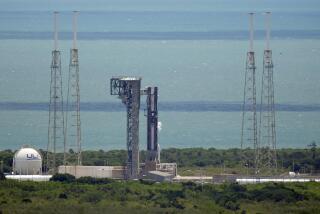Only 5 Minutes Left, Atlantis Lifts Into Orbit
- Share via
KENNEDY SPACE CENTER, Fla. — With only five minutes left in its 64-minute launch “window,” the space shuttle Atlantis roared into orbit on a cloud of flame and smoke at 11:47 a.m. PDT Thursday, launching the United States into a new era of planetary exploration after an 11-year hiatus.
A little over six hours after launch, at 6:01 p.m., Atlantis carried out its prime objective when mission specialist Mark C. Lee triggered a spring-loaded platform that sent the $325-million Magellan spacecraft spinning from the orbiter’s 60-foot-long payload bay.
Exactly an hour later, after Atlantis had moved a safe distance away from it, the first of Magellan’s two solid rocket motors ignited, launching the craft on its 15-month, 800-million-mile voyage to Venus, where it will use radar to map the surface of Earth’s sister planet.
Magellan is the first interplanetary probe launched by the United States since 1978, and the first ever launched by the shuttle. With it, NASA is entering an unprecedented period of scientific activity that will include the launch of the Galileo probe to Jupiter in October and the orbiting of the Hubble Space Telescope in December.
“Nobody is ever going to question our leadership in planetary science again,” said Lennard Fisk, NASA’s associate administrator for space science.
Earlier in the afternoon, the astronauts had expressed delight with their perfect, if delayed, launch. “Four of us are happy to be back in space, and the fifth is happy to be here,” radioed commander David M. Walker shortly after Atlantis entered its 160-mile-high orbit.
“It was quite a cliffhanger,” said acting NASA administrator Dale D. Myers, referring to the cloud cover at Kennedy’s main runway, where Atlantis would have landed if the launch were aborted.
Cloud cover at the site forced a 59-minute delay in the launch, almost causing the mission to be scrubbed for the second time in six days. An attempted launch last Friday was halted 31 seconds before liftoff when a cooling pump on one of the shuttle’s engines failed.
Thursday’s weather was a sharp contrast to last Friday’s perfect conditions. A light rain soaked Atlantis on pad 39B for an hour shortly after dawn, and thick clouds threatened rain for most of the day. Air Force meteorologist Capt. Thomas Strange noted that “all of the clouds on the (Florida) peninsula” seemed to be right over Cape Canaveral and Kennedy.
But a brisk breeze from the ocean blew most of the clouds westward at the last minute, and chief astronaut Dan Brandenstein, flying over the Kennedy landing strip, finally reported that the skies were clear enough for an emergency landing if one proved necessary.
Beyond the weather, the countdown went virtually flawlessly, and launch director Robert B. Sieck called it “exhilarating.”
“Did somebody win the pool up there?” mission control commentator John Creighton asked the crew. “We had only five minutes left in the window.”
“We wouldn’t want to push it any closer,” replied Walker.
It was the fourth shuttle launch since the space program was jarred by the January, 1986, destruction of Challenger and the 60th manned launch in the U.S. space program. Four more shuttle launches are scheduled for this year, including the first post-Challenger flight of Columbia, which is still in the process of being refitted with changes mandated after the Challenger accident.
Magellan, designed at Jet Propulsion Laboratory and assembled by Martin-Marietta Corp., will not reach Venus until Aug 10, 1990, when its braking rocket will shift it into a 3-hour, 9-minute elliptical orbit. For 37.2 minutes of each orbit, a sophisticated radar system built by Hughes Aircraft Co. will map an 18-mile-wide swath of the planet’s surface. It will then use the rest of the orbit to radio the data back to Earth.
In the 243-day primary phase of the mission, Magellan will map 80% of Venus’s surface, sending back more data than all previous planetary probes combined.
Scientists hope the data will allow them to understand the motion of tectonic plates on Venus, shedding new light on the causes of earthquakes on Earth, where tectonic motion is obscured by erosion and weathering.
They also hope to learn more about the conditions that caused a so-called runaway greenhouse effect on Venus, which raised its surface temperature to nearly 900 degrees Fahrenheit.
The other members of the crew are pilot Ronald J. Grabe and mission specialists Mary L. Cleave and Norman E. Thagard.
Atlantis is scheduled to land at Edwards Air Force Base at 12:44 p.m. PDT Monday.
THE ATLANTIS ASTRONAUTS Navy Capt. David Walker, Commander
Age: 44
Air Force Colonel Ronald Grabe, Pilot
Age: 43
Environmental engineer Mary Cleave, Mission specialist
Age: 42
Medical Doctor Norman Thagard, Mission specialist
Age: 45
Air Force Major Mark Lee, Mission specialist
Age: 36
More to Read
Sign up for Essential California
The most important California stories and recommendations in your inbox every morning.
You may occasionally receive promotional content from the Los Angeles Times.













